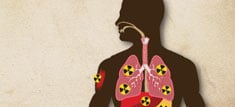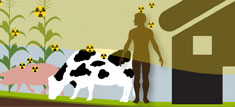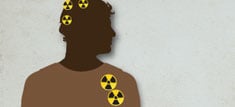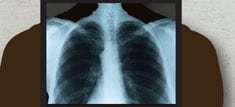With the recent nuclear catastrophe happening in Japan as well as the probability that nuclear events will continue to be a part of our world, it’s prudent to have good reference information as to how the body can be supported (using natural means) and protected should high radiation exposure become a reality. Knowledge and information empower and should always propel one toward effective preparation and planning, not fear. The power of fear is destructive in that it paralyzes resulting in unwise decisions. Along with knowledge and preparedness, we must also be aware of the very real probability that the general public will not be privy to factual information. Hopefully my readers will copy this information and place in a safe place for future reference.

Fighting Radiation & Chemical Pollutants with Foods, Herbs, & Vitamins by Steven R. Schechter, ND was required reading when I was studying for my ND. It’s difficult now to find copies at a reasonable price of this out of print but very informational book. Below are some of the chapter titles and information that Dr. Schechter deals with in his book as well as some of my own research/suggestions.
“These foods and food substances will enhance the immune system and protect
against the dangerous side effects of radiation.” –Dr. Steven R. Schechter.
The time to implement these foods is now in order to build up the body as well as the immune system. Most of the foods and vitamins/minerals are “protective” meaning that they should be implented before a radiation event occurs.
Each of these can be researched individually on the Internet such as “bee pollen+nuclear radiation protection”, etc. in order to find out how it is helpful/useful to the body.
Fighting Radiation with Food
Sea Vegetables – According to a 1964 McGill University study published in the “Canadian Medical Association Journal,” sodium alginate from kelp reduced radioactive strontium absorption in the intestines by 50 to 80 percent. The sodium alginate allowed calcium to be absorbed through the intestinal wall while binding most of the strontium, which was excreted out of the body. Some of the more popular sea vegetables to consume are kelp, arame, wakame and kombu. Canadian researchers reported that sea vegetables contained a polysaccharide substance that selectively bound radioactive strontium and helped eliminate it from the body. In laboratory experiments, sodium alginate prepared from kelp, kombu, and other brown seaweeds off the Atlantic and Pacific coasts was introduced along with strontium and calcium into rats. The reduction of radioactive particles in bone uptake, measured in the femur, reached as high as 80 percent, with little interference with calcium absorption. “The evaluation of biological activity of different marine algae is important because of their practical significance in preventing absorption of radioactive products of atomic fission as well as in their use as possible natural decontaminators.” Source: Y. Tanaka et al., “Studies on Inhibition of Intestinal Absorption of Radio-Active Strontium,” Canadian Medical Association Journal 99:169-75, 1968.
The Atomic Energy Commission recommends for maximum protection against radioactive poisoning for humans, taking a minimum of 2 to 3 ounces of sea vegetables a week or 10 grams (two tablespoons) a day of sodium alginate supplements. During or after exposure to radiation, the dosage should be increased to two full tablespoons of alginate four times daily to insure that there is a continual supply in the GI or gastrointestinal tract. There may be a rare concern of constipation but this can be avoided if the sodium alginate is made into a fruit gelatin. Agar, derived from sodium alginate in kelp, is a safe, nontoxic substance that can be used as a thickening agent or gelatin.
Bee Pollen – Studies show that bee pollen can significantly reduce the usual side effects of both radium and cobalt-60 radiotherapy and also the sickness after massive abdominal x-rays. One study showed that the proliferation of cancer cells stopped in cancerous tumors induced in mice. (This is only indicative and does not purport to be medical advice. One should go to the source and study the relevant information before drawing conclusions. Try to get real bee pollen from an organic bee keeper, uncooked.)
Bee Propolis – Besides the healing and anti bacterial qualities of this substance, it has been effective in clinical stages of radioepithelitis, i.e. inflammation of epithelial tissue due to radiation. (Same as above. Get unheated, raw organic honey; it is a good source of pollen, royal jelly and propolis.)
Beets – Beets have been shown to rebuild hemoglobin of the blood after exposure to radiation. Rats fed a diet of 20 percent beet pulp were able to prevent cesium-137 absorption and 97 to 100 percent more effectively than rats given no beets.
Dried, Primary-Grown Nutritional Yeast – Besides having Vitamin E, it also contains the nucleic acids RNA and DNA, both of which have been shown to have radio protective qualities. It has been shown to help rebuild and regenerate cells damaged by radiation, and also to produce relief from radiation poisoning and it’s many horrible symptoms. Nutritional yeast has a good amount of many important nutrients. Primary –grown yeasts bonds with and absorb heavy metals such as uranium, lead and mercury!
Garlic – Garlic’s high sulfur content supports natural antioxidant systems like glutathione. Garlic extracts protect red blood cells from radiation damage by a glutathione-related mechanism. In mice, garlic extracts prevented radiation damage to chromosomes in vulnerable bone marrow cells.
Onions – Cysteine, present in onions, binds with and deactivates both the radioactive isotopes and toxic metals such as cadmium, lead and mercury. The sulfur in cysteine helps the kidneys and liver detoxify the body.
Chlorophyll – A Report by Scottist in 1986 and report from Japan showed that increase absorption of Cadmium by Chlorella and increased excretion of Cadmium by threefold after intake of Chlorella from animal testing. Chlorella can also detoxify Uranium, Lead, Copper, PCB. Source: ” A good Health Guide: Chlorella ” by William H Lee. R. Ph.D. and Michael Rosenbaum, M.D. Guinea pigs on a diet rich in chlorophyll showed increased resistance to lethal X-rays.
U.S. Army report in 1950
Oils – Plant oils such as unrefined and cold-pressed olive oil, flaxseed oil.
Foods rich in pectin – Pectin is able to bind radioactive residues and remove them from the body. It also acts as a natural chelating agent. Apples, guavas, plums, gooseberries, oranges and other citrus fruits are recommended. Be sure to effectively wash all fruit/vegetables before consuming.
Fighting Radiation with Vitamins & Minerals
Vitamin A – In 1974, researchers from India found that vitamin A, when taken internally by humans, hastened recovery from radiation. In 1984, Dr. Eli Seifter and a team of researchers fro the Albert Einstein College of Medicine….reported vitamin A and beta-carotene counteracted both partial and total body gamma radiation. It also improved the healing of wounds; reduced weight loss, thymic and splenic atrophy, and adrenal enlargement; and prevented gastro-ulceration and an abnormal decrease in red and white blood cell formation. (The therapeutic purposes, 25,000 to 35,000 IU are recommended for adults. During emergencies or crisis situations, intensive exposure may warrant as much as 40,000 to 100,000 IU of beta-carotene, but should be taken for no more than three to four weeks. Infants should not consume high amounts. This info is only very partial and you should consult the book for specifics.)
Vitamin C & Bio-flavonoids – Italian researchers in 1966 found that Vitamin D, in combination with vitamins A and the entire B Complex, helps remove radioactive isotopes such as strontium-85 and strontium-90 from the bones and the body. Vitamin D also helps protect against some common pollutants, including lead and cadmium, according to Airola in How to Get Well.
Vitamin E (natural not synthetic) – Radiation destroys leukocytes in both tissues and the blood, according to S. L. Robbins in Pathologic Basis of Disease ( W. B. Saunders, 1974). In Japan, I. Kurokawa and co-workers found that blood given vitamin E maintained a white cell count twice as high as blood not given vitamin E but exposed to the same radiation. Vitamin E has also been shown to produce internal and external protection in mice irradiated by cesium-137. Vitamin E and selenium are best taken at the same time since selenium preserves vitamin E.
Interesting to note about the ACE (Vitamins A-C-E) – A remarkable study among X-ray technicians reveals just how powerful antioxidant vitamins can be. Radiology techs are nominally protected by elaborate shielding, but they’re still exposed to unnaturally high levels of radiation over the course of a lifetime. As a result they tend to have higher levels of tissue oxidation. But when a group of techs was supplemented with vitamins C (500 mg) and E (150 mg) daily for 15 weeks, their markers of tissue oxidation plummeted, and their levels of natural antioxidants (such as glutathione in red blood cells) rose significantly. (Kayan M, Naziroglu M, Celik O, Yalman K, Koylu H. Vitamin C and E combination modulates oxidative stress induced by X-ray in blood of smoker and nonsmoker radiology technicians. Cell Biochem Funct. 2009 Oct;27(7):424-9.)
B3 Nicotinic Acid – Have on hand the Acid form of B3 rather than the salt form, Niacinamide, which is basically useless. Several sources indicate that large doses of niacin B3 were used in treating victims of radiation poisoning after the Chernobyl meltdown. B3 will cause the body to detox and therefore it is wise to make sure that your liver has been detoxed and is supported properly. Chemical poisoning slows down the liver.
Calcium – Protects against strontium-90, calcium-45 and other radioisotopes.
Magnesium – Like Calcium, magnesium prevents the uptake of strontium-90 and other radioisotopes. It helps to eliminate already absorbed strontium-90 as well. One study has shown that exposure to gamma radiation can decrease calcium and magnesium levels in the blood. As a result, optimal levels of both minerals in the diet are essential after one is exposed to higher amounts of radiation.
Selenium – As selenomethionine. Has been shown to decrease the mortality rate of rats exposed to irradiation, and to alleviate leucopenia (abnormal decreases of white blood corpuscles). Selenium greatly reduces cancer in animals exposed to cancer-causing agents.
Zinc – Natural zinc will help the body eliminate several toxic heavy metals, including cadmium, aluminum, lead, and excess copper.
Potassium – Cesium-137, cesium-134, potassium-40, and potassium-42 are radioactive, competitive sister elements of natural potassium, all of which are in the same chemical family. These radionuclides are absorbed by the body when there is a deficiency of natural potassium. They concentrate primarily in the reproductive organs and the muscles. Cesium-137 is common in nuclear fallout, and can often be detected in our food, soil, and water. The authors of one study described our biosphere as “contaminated with radiocesium.” Researchers discovered that after the accident at Chernobyl, iodine-131 and cesium-137 were the most prevalent radionuclides in samples of food from the USSR and from Poland, Hungary, and other parts of Eastern Europe. Cesium-137 is also already being used in some countries to irradiate foods as a means of extending their shelf life at the supermarket. Research by the Food and Nutrition Board of the National Academy of Sciences demonstrates that natural potassium decreases the concentration of radiocesium. Begin to add potassium rich foods such as bananas, potatoes+peels, etc. If a nuclear event escalates in which cessium is being released, then also adding supplemental potassium is recommended. Potassium regulation is affected by magnesium. For magnesium deficiency include leafy green veggies, pumpkin seeds, sunflower seeds and black beans
Iron – Research done in Czechoslovakia showed that whole body irradiation disturbed absorption of iron, and functions of red blood cells, plasma, and bone marrow. Other researchers found that amma-irradiation of the whole body or of the abdomen decreased absorption of iron, vitamin B12 and lipids.
MSM – As plants take in MSM from the soil they change it into amino acids such as methionine, cysteine and taurine which can protect against radiation as well as chelate heavy metals for elimination from the body. MSM also regulates the fluid that covers the airway surface of the lungs, preventing an inflammatory response and helping to regulate the exchange of oxygen and carbon dioxide.
Fighting Radiation with Herbs
Siberian Ginseng – Soviet researchers have reported that eleuthero extract has radioprotective abilities, and can be used therapeutically in conditions of acute and chronic radiation and sicknesses such as hemorrhaging, severe anemia, dizziness, nausea, vomiting , and headaches due to x-rays.
Panax Ginseng – Hemorrhage was a symptom of humans exposed to atomic radiations in Hiroshima and Nagasaki. Japanese research doctors found that “Panax ginseng prevented hemorrhaging tendency after x-irradiation.” Bone marrow death is one result of radiation damage to blood-forming tissues. It occurs ten to twenty days after exposure to high doses of radiation. Panax ginseng extract prevents bone marrow death and accelerates normalization of red and white blood cell counts in animal studies.
Gingko Biloba – According to Science News Daily, extracts of its leaves contain antioxidant compounds including glycosides and terpenoids known as ginkgolides and bilobalides. These compounds are thought to protect cells from damage by free radicals and other reactive oxidizing species found in the body. These are generated continuously by the body’s normal metabolism, and in excess in some diseases or after exposure to pollution or radiation. They damage proteins, DNA and other biomolecules and left unchecked can kill cells. Results suggest that ginko biloba extracts can neutralize the free-radicals and oxidizing agents produced in the cells by the radiation and so prevent them from undergoing apoptosis.
Black & Green Tea – The polyphenol epigallocatechin gallate (EGCG) derived from green tea protects animals from whole-body radiation, blocking lipid oxidation and prolonging life span. Several sources indicate that there were hundreds who survived Hiroshima at ground zero and the one thing they all had in common was drinking 20 cups of green tea per day.
Astragalus – An article published in Cancer, a publication of the American Cancer Society, reported that the aqueous extract of Astragalus membranaceus restored the immune functions in 90 percent of cancer patients studied.
Milk Thistle & Liver Support – A report suggests that milk thistle may prevent radiation toxicity. It enhances liver regeneration after exposure to heavy metals, radiation, or toxic chemicals. It reduces DNA damage and extends survival in animals exposed to dangerous levels of radiation. Silymarin’s free radical scavenging and direct antioxidant effects are credited with producing these results.
Fighting Radiation with Miscellaneous Substances
Distilled Water – Dr. Kenneth Sutter recommends drinking lots of distilled water for radiation poisoning. A tiny pinch of good quality sea salt in several glasses of distilled water each day will provide one with all the minerals and trace elements they need to stay healthy.
N-acetylcysteine – A glutathione precursor. As a source of sulfhydryl groups, NAC stimulates glutathione (GSH) synthesis, enhances glutathione-S-transferase activity, promotes liver detoxification by inhibiting xenobiotic biotransformation, and is a powerful nucleophile capable of scavenging free radicals. Studies at the Louisville School of Medicine have shown that Glutathione possesses a unique ability to slow the aging process. While Glutathione aids in the protection of all cells and membranes, a study at Harvard Medical School found that glutathione is especially able to enhance immune system cells, protecting against damage from radiation and helping to reduce the side effects of chemotherapy, x-rays, and alcohol. As a detoxifier of metals and drugs, glutathione also aids in the treatment of blood and liver disorders.
SSKI – Super Saturated Potassium Iodide. Protects ONLY the thyroid from radioactive idoine. If it is radioactive cessium that is being released, potassium iodide will not be effective for the areas where cessium will accumulate – mainly the reproductive system, kidneys and liver. (see potassium recommendations above) FDA – “It is also notable that the thyroid radiation exposures after Chernobyl were virtually all internal, from radioiodines. Despite some degree of uncertainty in the doses received, it is reasonable to conclude that the contribution of external radiation was negligible for most individuals. This distinguishes the Chernobyl exposures from those of the Marshall Islanders. Thus, the increase in thyroid cancer seen after Chernobyl is attributable to ingested or inhaled radioiodines. A comparable burden of excess thyroid cancers could conceivably accrue should U.S. populations be similarly exposed in the event of a nuclear accident. This potential hazard highlights the value of averting such risk by using KI as an adjunct to evacuation, sheltering, and control of contaminated foodstuffs.” This may reduce the risk of developing thyroid cancer in the future. Potassium iodide does not provide immediate protection from radiation damage, and does not have protective effects against other radiation exposure complications.
SSKI Dosage information: Adults: dose = 130mg KI; Children between 3 and 18 years of age: dose = 65mg KI; (Children who are 150 pounds or over should take the adult dose regardless of age.); Infants and children between 1 month and 3 years of age: dose =32mg KI; This dose is for nursing and non-nursing infants/children Newborns from birth to 1 month of age: dose = 16mg KI This dose is for both nursing and non-nursing newborn infants. Take one dose every 24 hours until the danger is past.
Beta-1,3 Glucan: Extracted from the cell walls of baker’s yeast it is a potent immune enhancer. It activates important macrophages and is also an anti oxidant. Studies by the Army showed that glucan was a powerful protectant against a lethal dose of radiation.
Lecithin – 2-3 tbsp. a day, will help counteract harmful effects of radiation.
Papain – In one particular study, 50 percent of rats that were given papain survived a normally lethal dose of radiation.
Thymus Extract – Animal studies demonstrate that thymus tissue extract can re-create immunity even after doses of radiation powerful enough to kill the all- important lymphoid tissue. The idea of thymus glandular feeding in cases of mild to extreme radiation exposure has been applied in numerous cases.
Charcoal – Has the ability to absorb and neutralize radioactive substances and some toxic materials. Researchers report that 10 grams or 1 tablespoon of charcoal can absorb about 3 to 7 grams of materials. German researcher found that charcoal air filters removed more than 70 percent of radioactive iodine from the air. Taking finely powdered charcoal has been found to be one-and-a-half times as effective as the tablets.
Organic Germanium 132 – Should be used in gram amounts for effectiveness. According to one study, “Radioactive rays release electrons that destroy cells and blood corpuscles….Germanium floating near the blood corpuscles skillfully catches those released electrons and lets them move around its nucleus.” In other studies mutagenesis of cells exposed to cesium-137 and gamma rays, was “remarkably reduced” without affecting cellular growth or survival. It seemed to improve the fidelity of DNA replication. Ge-132 protects cysteine, an amino acid with known protective value. Dose: 25 mg. to 100 mg. per day is often used in Japan. It can be derived from onions, pearled barley, and watercress.
Other Recommendations
Natural Geiger Counter: There is a plant that is a natural Geiger counter. The spiderwort plant is so sensitive to changes in radiation levels (its petals change color upon exposure) that it’s often used as a natural radiation detector (dosimeter), just as they use canaries in mines as detectors of poisonous gas. Some people like knowing that they have an ongoing monitoring system for radiation in the environment, and this is just another tip available in “How to Neutralize the Harmful Effects of Radiation or Radioactive Exposure.”
Sea Salt & Baking Soda & Clay – Add one pound of good quality sea salt and 1 pound of baking soda to chlorine-free water. Soak for 20 minutes and then rinse with cool water. Adding one pound of betonite, or other safe clay, to the sea salt and baking soda will increase the removal of radiation. Some specialists who work with radioactive isotopes use this method to remove radiation from their body. For an abnormaly high level of radiation exposure one can use this method three times a week for one month.
Sodium Bicarbonate – Dr. Mark Sircus writes, “So useful and strong is Sodium Bicarbonate that at Los Alamos National Laboratory in New Mexico, researcher Don York has used baking soda to clean soil contaminated with uranium. Sodium bicarbonate binds with uranium, separating it from the dirt; so far, York has removed as much as 92 percent of the uranium from contaminated soil samples…the United States Army recommends the use of bicarbonate to protect the kidneys from radiation damage…sodium thiosulfate can be added to baths and that instantly neutralizes any chlorine in the bath water while simultaneously providing sulfur for the vital sulfur pathways.” “Uranium is one of the only metals that get significant bonding from carbonate. Just flushing a lot of bicarbonate through the system, along with whatever kidney support you are going to use, will be very helpful,” writes Dr. Chris Shade.
Probiotics – A 2007 study of 490 patients receiving radiation for various types of cancer found that those consuming probiotics throughout treatment were less likely to experience radiation-induced diarrhea.
Zeolite – Zeolites have been used to decontaminate animals, particularly sheep and reindeer, which have ingested radiation following nuclear disasters such as Chernobyl. Addition of zeolites to contaminated soils has shown to reduce up-take of radionuclides by plants, and hence, reduce the spreading of contamination through the food chain. (Introduction to Zeolite Science and Practice by Herman van Bekkum). Do not take any product containing zeolite if you are taking any prescription medication containing heavy metals, such as lithium, or containing platinum, which can be found in some cancer medications or Radiotherapy with chemotherapy check with your practitioner.
More Info for Contemplation
People Died at 3 Mile Island
Radiation Monitoring Map for the USA
References
1. Steven R. Schechter, N.D., “Fighting Radiation and Chemical Pollutants with Foods, Herbs and Vitamins”, 1997.
2. Life Extension – www.lef.org
3. Treatments for Nuclear Contamination by Mark Sircus
Source: Oasis Advanced Wellness







